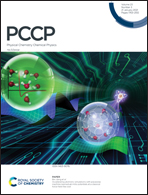High mobility and enhanced photoelectric performance of two-dimensional ternary compounds NaCuX (X = S, Se, and Te)†
Abstract
Two-dimensional (2D) materials have attracted great interest in the field of optoelectronics in recent years due to their atomically thin structure and various electronic properties. Based on the first-principles calculations combined with the non-equilibrium Green's function (NEGF) method, we predict a set of new 2D ternary materials, sodium copper chalcogenides (NaCuX, X = S, Se, and Te). These materials not only have direct band gaps ranging from 1.2 to 1.6 eV, but also possess relatively small carrier effective masses (0.1–0.2m0) at the band edges thus high carrier mobilities (103–104 cm2 V−1 s−1), which collectively imply that they are suitable for optical-electronic applications in the visible (even in the infrared) light region. Moreover, based on the high photo responsivity (Rph), e.g., up to 0.105 A W−1 for NaCuTe, we design a series of NaCuX monolayer based high performance optoelectronic junctions. These properties indicate that NaCuX monolayers are promising candidate materials for photodetectors and photovoltaic units.



 Please wait while we load your content...
Please wait while we load your content...